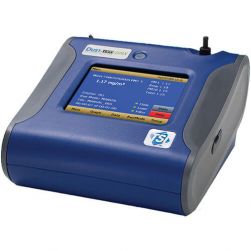TSI University Training: Getting Started with the TSI DustTrak II and DustTrak DRX Aerosol Monitors
Instrument Setup
This short video walks you through identifying the ports and components of TSI DustTrak II or DustTrak DRX aerosol particle monitors, what comes in the kit, setting up the DustTrak for operation, and turning it on for operation.
Interface Screen Setup
This 10-minute video introduces you to the graphical user interface of the DustTrak unit (using a DRX desktop model as an example), so you can learn where to find all the data and commands available on your dust monitor. The speaker, TSI's Greg Olsen, also goes into detail about how to change parameters on the touchscreen.
How to Manually Zero Your Unit
This three-minute video walks you through how to zero the DustTrak II or DustTrak DRX using the TSI filter included with each unit. It's important to zero the instrument before each use to reduce zero drift in the electronics for a true reading of mass concentration. Zero drift can occur if the instrument is run for long periods of time, or from temperature and humidity changes during previous measuring
Using the Auto Zero Module
This video describes how and why you'd use the DustTrak II or DustTrak DRX with an auto-zero module. The auto-zero module is designed specifically for long-term sampling applications, like 24-hour indoor air quality monitoring or for fugitive emissions monitoring. Includes how to attach and set up the auto zero module for a sampling run. Zero drift can occur if the instrument is run for long periods of time, or from temperature and humidity changes during previous measuring events.
Using Survey, Manual Log and Program Log Modes
How to program a DustTrak II or DustTrak DRX dust monitor to sample, either in survey (non-logging) mode, manual (quick setup) logging mode, or program log mode (more detailed sample mode for long-term sampling or multiple samples.
TSI DustTrak II: Size Selective Inlet Conditioners
This video looks at using size-selective inlet conditioners, including PM10, PM4, PM2.5, and PM1 size fractions to get specific thoracic or respirable size fractions, by cutting the particle size using specific impactors. These impactors change air velocity flowing through the system.




